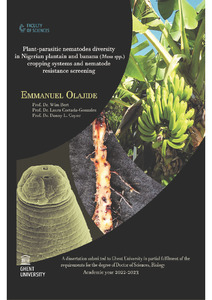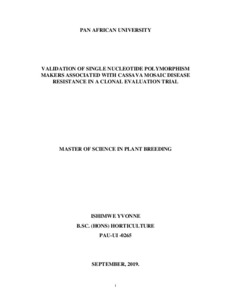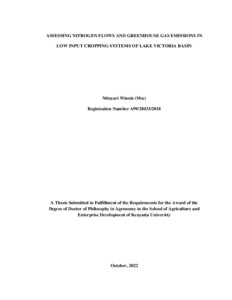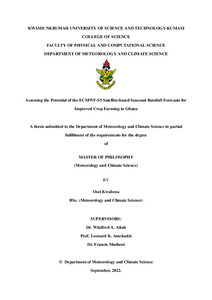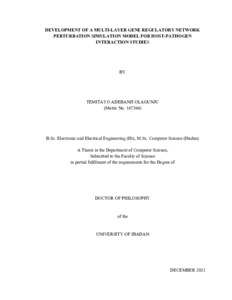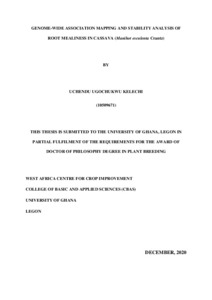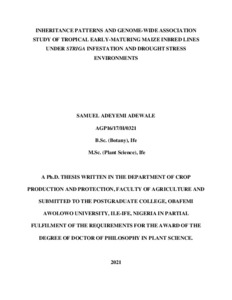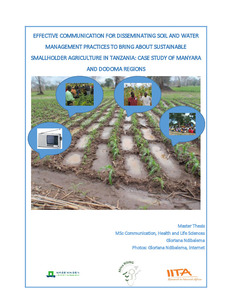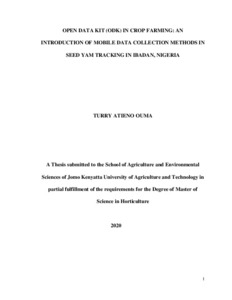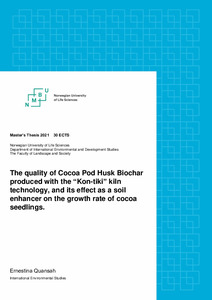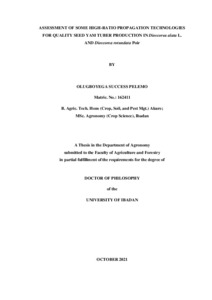Welcome to the International Institute of Tropical Agriculture Research Repository
Theses and Dissertations: Recent submissions
Now showing items 21-40 of 111
-
Plant-parasitic nematodes diversity in Nigerian plantain and banana (Musa spp.) cropping systems, and nematode resistance screening
(Ghent University, 2023-03-24) -
Validation of single nucleotide polymorphism makers associated with cassava mosaic disease resistance in a clonal evaluation trial
(University of Ibadan, 2019-09)Cassava is an important staple crop in Africa for almost half of the population. The main biotic constraint of the crop is Cassava Mosaic Disease (CMD) which causes significant losses on farmers’ field. The conventional screening for CMD resistance in new cassava populations is time-consuming, expensive and not highly reliable. However, there are newly developed Single Nucleotide Polymorphism (SNP) markers linked to CMD resistance which have not been validated. Therefore, the objective of this ... -
Response of cocoa (Theobroma cacao L.) seedlings to folia fertilizer application and fertigation
(Kwame Nkrumah University of Science and Technology, 2023-03)The production of quality and vigorous seedlings is important for sustainable cocoa production. A greenhouse nursery study was conducted in 2019/2020 at CRIG to assess the effects of foliar fertilizer application and fertigation on soil chemical properties, nutrient uptake and growth of cocoa seedlings. The study was 4x3 factorial experiment, laid out in completely randomized design with 13 treatments and three replicates. Two liquid fertilizers (NPK 24:17:18 and NPK 10:10:10) and two granular ... -
Assessing nitrogen flows and greenhouse gas emissions in low input cropping systems of Lake Victoria Basin
(Kenyatta University, 2022-10)Too little nitrogen (N) is a threat to cropping systems and soil fertility in sub-Saharan Africa (SSA). Nitrogen budgets (NB) and nitrogen use efficiency (NUE) are critical tools for assessing N dynamics in agriculture and have received little or no attention in the region. The study aimed to assess key N performance indicators at field and farm level based on N use scenarios and help to inform policy on formulating relevant decision and practices to enhance N management for improved crop productivity ... -
Effects of potassium and magnesium on cassava vegetative and root yield
(University of Eldoret, 2022-10)Cassava (Manihot esculentum) has a high potassium (K) demand and its application does not generally increase yields. Potassium may have antagonistic effects on magnesium (Mg) leading to deficiency of Mg in the soil. The objectives of this study were to (I) evaluate the vegetative growth of cassava under different K and Mg fertilizer combinations and (ii) determine the effects of K and Mg fertilizer on cassava storage root yield. A 2-cropping season experiment was conducted in a randomized complete ... -
Assessing the potential of the ECMWF-S5 satellite-based seasonal rainfall forecasts for improved crop farming in Ghana
(Kwame Nkrumah University of Science and Technology, 2022-09)Forecasts of seasonal rainfall are important for the agricultural sector, particularly in nations where rain-fed agriculture is predominant. A robust agricultural system is made possible by the ability to predict seasonal rainfall with accuracy and precision. Due to the limited and sparse availability of gauge data, both satellite-based and model seasonal rainfall forecasts are beneficial for predicting seasonal rainfall. While seasonal rainfall forecasts based on models and satellites complement ... -
Bias correction of daily chirps-V2 rainfall estimates in Ghana
(Kwame Nkrumah University of Science and Technology, 2022-10)A wide range of economic sectors in the Ghana, including agriculture, health care, and energy, heavily rely on climate data; as a result, having access to reliable climate data is crucial for research and economic growth yet rainfall gauge data in Ghana scarcely available, therefore, researchers tend to depend on satellite estimates for hydrological studies and impact assessments. However, biases in satellite rainfall estimates and the ability for these rainfall products to effectively capture ... -
Impact and adoption of drought tolerant maize varieties and interrelated agricultural technologies on rural households productivity and welfare
(University of Greeenwich, 2021)Over the years, climatic variations have persistently induced technological interventions in developing countries and were strategic in varietal development and modification of agronomical practices in developing countries. In addition, there are overwhelming records of impact on productivity and welfare of rural farm households. Despite these efforts, low adoption continues to be a huge problem and a clog to meeting sustainable agricultural development goals. This research contributes to the large ... -
Adoption et perception des producteurs Nigeriens face aux changements climatiques et l'utilisation des varietes ameliorees
(Institut de Strategie D'evaluation et de Prospective, 2021)L’agriculture Nigérienne fait face à une faible production agricole car étant une agriculture pluviale à faible rendement, et l’élevage, un élevage extensif tributaire des ressources naturelles. IL est de plus en plus admis que le réchauffement planétaire actuel ne peut être évité (IPCC, 2007). Le recours à l’adoption des technologies agricoles améliorées s’est avéré indispensable pour une augmentation de la production agricole dans le but d’améliorer le bien-être des producteurs. Ainsi, dans notre ... -
Physicochemical parameters and functional properties of flours from advanced genotypes and improved cassava varieties for industrial applications
(University of Malawi, 2021-08)Cassava has potential for many industrial uses, which provide an opportunity for more rewarding markets. Therefore, significant research on improved varieties, targeting industrial applications, is required as a possible approach to spur improvements in the value chain. In addition, the promotion of cassava for production, targeting industrial applications, requires information on yield and stability performance of cassava genotypes and varieties in a diverse range of environments. To this end, ... -
Development of a multi-layer gene regulatory network perturbation simulation model for host-pathogen interaction studies
(University of Ibadan, 2021-12)Gene Regulatory Networks (GRNs) modulate the traits of an organism. Perturbation experiments which were employed to identify Trait-influencing Genes (TGs) are limited to only a few genes at once, and inadequate to identify the TGs of complex traits like disease resistance. Network modelling techniques for complex systems such as GRNs can provide a holistic system view to overcome the limitation of identifying TGs of complex traits with perturbation experiments when applied to genome-wide Next ... -
Genome-wide association mapping and stability analysis of root mealiness in cassava (Manihot esculenta Crantz)
(University of Ghana, 2020-12)Cassava breeders have made significant progress in developing new genotypes with improved agronomic characteristics such as improved root yield. However, these new and improved cassava genotypes in cultivation in Nigeria have undergone little or no improvement in their culinary qualities; hence, there is a paucity of information on the texture of boiled cassava roots, particularly with regard to its mealiness. The objectives of this study were to: (i) elicit farmers’ knowledge, perceptions and ... -
Effects of agroforestry and climate on cocoa yield, pests and diseases
(University of Ghana, 2021-06)Cocoa (Theobroma cacao) originates from the Amazon basin in South America. The crop is cultivated across many tropical regions, with the largest production from West Africa, where Ghana and Cote d’Ivoire contribute 70% of global production. Two major systems dominate cocoa production; a full-sun monocropping system where the cocoa crop is grown without shade trees, and an agroforestry system where cocoa is grown with deliberately planted or retained forest/fruit trees. Aside soil fertility and ... -
Rapid detection of adulterated fermented maize (Ogi) with sorghum leaf sheath (Poroporo) using visible-near infrared spectroscopy
(University of Ibadan, 2022-03)Food adulteration is a very old and common problem, which is often seen in both the low-and middle-income countries and even in some developed countries. Maize-based porridge especially ogi is a high-value commodity and common indigenous complementary food that is a target for adulteration, leading to loss of quality and encroachment on the rights and interests of consumers. This study investigated the characterization of the microorganisms found in ogi fermented for 0 to 120 hours and the feasibility ... -
Inheritance patterns and genome-wide association study of tropical early-maturing maize inbred lines under striga infestation and drought stress environments
(Obafemi Awolowo University, 2021)This study determined the gene action controlling grain yield and other agronomic traits among newly-developed early-maturing maize inbred lines under drought stress, Striga infestation, optimal conditions and across research environments; examined the combining ability of the early maize inbred lines under each and across research environments; classified the inbred lines into heterotic groups using DArTseq (Diversity Arrays Technology sequencing) markers and combining ability effects methods and ... -
Effective communication for disseminating soil and water management practices to bring about sustainable smallholder agriculture in Tanzania: case study of Manyara and Dodoma regions
(Wageningen University and Research Center, 2019-05)This study investigated effective communication for disseminating soil and water management (SWM) practices for sustainable smallholder agriculture. Higher uncertainties in precipitation and land degradation are potentially the most limiting reasons for poor performance of rainfed agricultural sectors in Tanzania. Despite the increased focus on sustainable intensification of African agriculture and an increase of agricultural innovations with potential to alleviate these, adoption by smallholder ... -
Title Open Data Kit (ODK) in crop farming: an introduction of mobile data collection methods in seed yam tracking in Ibadan, Nigeria
(2020)The purpose of this paper is to illustrate the importance of applying open-source technologies for mobile-based data collection for real-time tracking of seed yam (Dioscorea rotundata and Dioscorea alata) production. Seed yam data in Nigeria have been predominantly collected using field notebooks in the past, which were subsequently entered into a Microsoft Excel spreadsheet or Access database for analysis and reposition. Relevant areas of weakness within the current data systems include time delay ... -
The quality of Cocoa Pod Husk Biochar produced with the "Kon-tiki" kiln technology, and its effect as a soil enhancer on the growth rate of cocoa seedlings
(Norwagien University of Life Sciences, 2021)A study was conducted to investigate the potential of cocoa pod husk as feedstock for biochar production using the “Kon-tiki” kiln. The effect of cocoa pod husk biochar (CPHB) as a soil enhancer, was tested in particular with respect to the soil’s capacity to retain moisture and nutrients, and their consequences for the growth rate of cocoa seedling on two soil types. The resultant CPHB biochar was applied on two soil types from Ghana, Acherensua (sandy loam and near neutral) soil and Ayinase ... -
Assessment of some high ratio propagation technologies for quality seed yam tuber production in Dioscorea alata L. and Dioscorea rotundata Poir
(University of Ibadan, 2021-10)Edible yams are widely cultivated staple food crops in the tropics, but their production is constrained by low multiplication ratio, which results in short supply of Seed Yam Tubers (SYT). The use of High-ratio Propagation Technologies (HrPT) could enhance quality and quantity of SYT. However, limited information is available on the use of HrPT and the amenability of yam varieties to HrPT for SYT production. In this study, the uses of some HrPT for quality SYT production in Dioscorea alata and ... -
Morphological characterization of cacao cultivars in different socio-ecological settings of Ghana
(Georg-August-Universitat Gottingen, 2022-07-15)Knowledge of Theobroma cacao morphological variability provides the foundation for the utilization and conservation of genetic resources in Ghana. This study concentrated on cacao varieties, varietal richness and diversity maintained on farmers` fields. The objectives of the study were (1) to assess varietal richness per farm and the level of homozygosity of cacao cultivars on farmers’ fields through morphological analysis and farm management. (2) To identify existing cacao cultivars in the ...

